Cost To Ship To Germany: The Ultimate Guide (2025)
Your Complete Guide to cost to ship to Germany
Understanding the Complexities of Shipping Costs to Germany
Shipping goods internationally can be a daunting challenge for businesses, especially when it comes to navigating the costs associated with sending items to Germany. As a key player in the European market, Germany attracts importers and exporters from around the globe. However, the intricacies of shipping logistics can lead to unexpected expenses that may impact your bottom line. From fluctuating shipping rates to varying customs regulations, understanding the total cost to ship to Germany is essential for businesses looking to expand their reach.
In this comprehensive guide, we will break down the various factors that contribute to shipping costs to Germany. We will explore the different shipping methods available, such as express courier services, standard freight, and postal services, each with its unique pricing structure and delivery timelines. By examining these options, you will be better equipped to choose the most suitable method for your specific needs.
Moreover, we will delve into the costs associated with each shipping method, offering insights into pricing models from major carriers like USPS, UPS, and DHL. Understanding the nuances of pricing—whether it’s based on weight, dimensions, or delivery speed—will empower you to make informed decisions that align with your budget.
Transit times are another critical aspect of shipping to Germany. We will provide an overview of the expected delivery times for various shipping options, which can range from a few days for express services to several weeks for economy shipping. This knowledge will help you set realistic expectations for your customers and streamline your supply chain.
Customs regulations can also significantly affect shipping costs and timelines. Our guide will outline the essential customs documentation required for shipping to Germany, including any potential duties and taxes that may apply. By being proactive in understanding these requirements, you can avoid costly delays and ensure smooth clearance through customs.
Lastly, we will discuss the risks associated with international shipping, including the potential for loss or damage during transit. We will cover insurance options and best practices to mitigate these risks, ensuring that your shipments arrive safely and on time.
By the end of this guide, you will have the expert knowledge necessary to navigate the complexities of shipping costs to Germany efficiently. Whether you are an established business or just starting out, our insights will help you make strategic decisions that enhance your international shipping experience.
Table of Contents
- Your Complete Guide to cost to ship to Germany
- Understanding Your Shipping Options: A Detailed Comparison
- Deconstructing the Cost: A Full Pricing Breakdown
- Transit Time Analysis: How Long Will It Take?
- Navigating Customs Clearance: A Step-by-Step Guide
- A Practical Guide to Choosing Your Freight Forwarder
- Incoterms 2020 Explained for Shippers
- Risk Management: Identifying and Mitigating Common Shipping Problems
- Frequently Asked Questions (FAQs) for cost to ship to Germany
- Conclusion: Key Takeaways for Successful Shipping
- Important Disclaimer
Understanding Your Shipping Options: A Detailed Comparison
Shipping goods internationally can be complex, especially when exporting to Germany. Various methods exist, each with unique benefits and drawbacks, and understanding these can significantly impact your logistics strategy and cost efficiency. Below is a comprehensive guide comparing different shipping methods, tailored for international shippers, importers, exporters, and business owners.
Overview of Shipping Methods
The following table summarizes the key shipping methods available for sending goods to Germany, focusing on their suitability, speed, cost, and advantages and disadvantages.
| Shipping Method | Best For | Speed | Cost Level | Key Advantages | Key Disadvantages |
|---|---|---|---|---|---|
| Sea FCL | Large shipments | 20-40 days | Low | Cost-effective for bulk, no weight restrictions | Longer transit time, port handling fees |
| Sea LCL | Smaller shipments | 20-45 days | Medium | Flexible for smaller loads, shared container costs | Slower than FCL, potential for damage during handling |
| Air Freight | Urgent shipments | 1-5 days | High | Fastest delivery, reliable schedules | Expensive, weight limits can apply |
| Rail Freight | Heavy goods | 10-20 days | Medium | Eco-friendly, cost-effective for large volumes | Limited routes, slower than air |
| Express Services | Time-sensitive shipments | 1-3 days | Very High | Door-to-door service, tracking included | Very high cost, weight and size restrictions |
Detailed Breakdown of Each Method
Sea Freight (FCL and LCL)
- What It Is: Sea freight involves transporting goods via cargo ships. FCL (Full Container Load) means shipping an entire container, while LCL (Less than Container Load) shares a container with other shipments.
- When to Use: Use sea freight when shipping large volumes of goods or when cost efficiency is a priority.
Pros:
– Cost-Effective: FCL rates are generally cheaper per unit than air freight.
– Capacity: Can handle large volumes without weight restrictions.
Cons:
– Transit Time: Slower than air freight, which can be a disadvantage for urgent shipments.
– Handling Fees: Additional charges at ports can accumulate.
Air Freight
- What It Is: Air freight involves transporting goods via aircraft, typically for urgent deliveries.
- When to Use: Ideal for time-sensitive shipments or high-value goods that need quick delivery.
Pros:
– Speed: Fastest shipping method, with delivery times ranging from 1 to 5 days.
– Reliability: Scheduled flights minimize delays.
Cons:
– Cost: Significantly more expensive than sea freight, making it less ideal for bulk shipments.
– Weight Limits: Restrictions on the weight and size of packages can apply.
Rail Freight
- What It Is: Rail freight involves transporting goods via train, often used for shipping across Europe.
- When to Use: Best for heavy goods and when shipping overland from nearby countries.
Pros:
– Eco-Friendly: Generally more sustainable than air and road transport.
– Cost-Effective: Competitive pricing for large volumes.
Cons:
– Limited Routes: Not all regions are accessible by rail, which can complicate logistics.
– Slower: Transit times are longer than air freight but can be faster than sea freight.
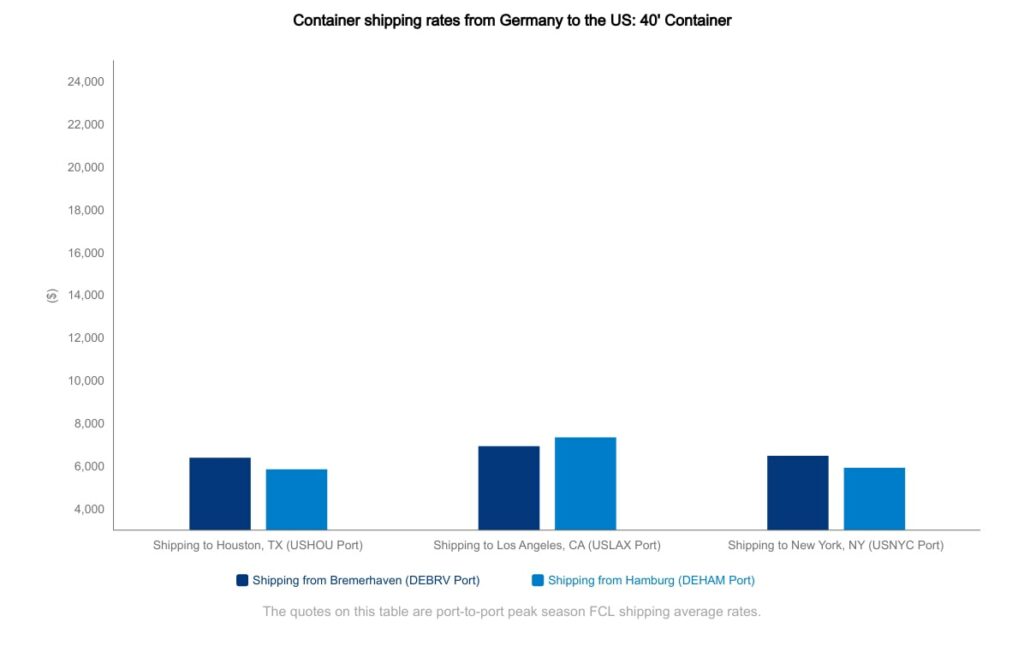
Express Services
- What It Is: Express services provide expedited shipping options, often including door-to-door delivery.
- When to Use: Use when time is of the essence and you need guaranteed delivery within a short timeframe.
Pros:
– Convenience: Door-to-door service with tracking capabilities.
– Fast Delivery: Typically delivers within 1 to 3 days.
Cons:
– High Cost: The most expensive shipping option available.
– Size and Weight Restrictions: Limited to smaller shipments.
Special Considerations
Multimodal Transport
Multimodal transport combines two or more modes of transport in a single journey. This approach is beneficial for optimizing cost and transit time. For example, goods might travel by rail to a port and then by sea to Germany. This method allows shippers to leverage the strengths of each transport type while mitigating their weaknesses.
Specialized Options
-
RoRo (Roll-on/Roll-off): Ideal for shipping vehicles and heavy equipment. Vehicles are driven onto the ship, minimizing handling and risk of damage. This method can be cost-effective for large machinery.
-
Break Bulk: Suitable for oversized cargo that cannot fit into standard containers. This method requires careful planning and handling but is essential for specific industrial shipments.
Conclusion
Understanding your shipping options is crucial for optimizing logistics and reducing costs when shipping to Germany. Each method offers unique advantages and disadvantages, making it essential to evaluate your specific needs—such as shipment size, urgency, and budget—before choosing the right one. By leveraging the strengths of various shipping methods and considering multimodal transport, you can enhance your shipping strategy and ensure a smooth delivery process.
Deconstructing the Cost: A Full Pricing Breakdown
Understanding the Cost to Ship to Germany
When it comes to international shipping, understanding the various costs involved is crucial for businesses looking to import or export goods. Shipping to Germany, a key player in the European market, involves several cost components that can significantly impact your bottom line. This guide breaks down the primary cost components and provides actionable insights for reducing shipping expenses.
Main Cost Components
Shipping costs can generally be divided into three primary categories:
- Main Freight
- Origin Charges
- Destination Charges
Each of these components plays a vital role in determining the overall shipping cost.
Main Freight
The main freight cost refers to the base charge for transporting your goods from the origin to the destination. This cost varies significantly based on the mode of transport—air freight or sea freight—and the weight and dimensions of the shipment.
- Air Freight: Generally faster but more expensive, air freight pricing is influenced by factors such as:
- Weight: Heavier packages incur higher costs.
- Volume: Larger dimensions can lead to additional charges.
-
Service Level: Express services will cost more than standard options.
-
Sea Freight: More economical for larger shipments, sea freight costs are influenced by:
- Container Size: Standard options include Full Container Loads (FCL) and Less than Container Loads (LCL).
- Shipping Route: Direct routes may cost less than routes with multiple stops.
- Fuel Surcharges: Fluctuating fuel prices can lead to variable shipping costs.
Origin Charges
Origin charges are fees incurred before the shipment leaves the originating country. These charges can include:
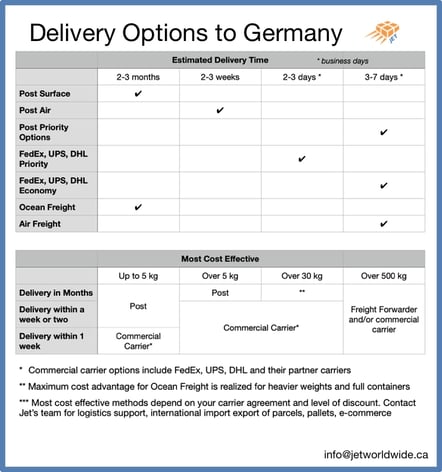
- Packaging: Proper packaging is essential to protect goods during transit, and costs can vary based on materials used.
- Pick-up Fees: Charges for the logistics company to collect goods from your location.
- Documentation Fees: Costs associated with preparing necessary shipping documents, such as commercial invoices and customs declarations.
- Insurance: While optional, many businesses choose to insure their shipments against loss or damage, adding to the origin costs.
Destination Charges
Once the goods arrive in Germany, additional destination charges may apply, including:
- Customs Duties and Taxes: Import duties depend on the product type and value. Germany follows EU customs regulations, which may include VAT.
- Handling Fees: Charges for unloading and processing goods at the destination port or warehouse.
- Delivery Fees: Costs to transport goods from the port to the final destination, which can vary based on distance and service level.
- Storage Fees: If goods are not picked up promptly, storage costs may accrue.
Detailed Cost Factor Analysis
Main Freight
| Mode of Transport | Cost Influencing Factors | Example Pricing Range |
|---|---|---|
| Air Freight | Weight, Volume, Service Level | $5 – $10 per kg |
| Sea Freight | Container Size, Shipping Route, Fuel Surcharges | $800 – $2,500 for 20ft FCL |
Origin Charges
| Charge Type | Description | Example Pricing |
|---|---|---|
| Packaging | Cost of materials to secure goods | $50 – $200 |
| Pick-up Fees | Collection fees by the logistics provider | $20 – $100 |
| Documentation Fees | Preparation of shipping documents | $10 – $50 |
| Insurance | Coverage for loss or damage | 1% – 3% of shipment value |
Destination Charges
| Charge Type | Description | Example Pricing |
|---|---|---|
| Customs Duties | Fees based on product classification and value | Varies (5% – 20% of value) |
| Handling Fees | Unloading and processing charges | $100 – $300 |
| Delivery Fees | Transport from port to final destination | $50 – $200 |
| Storage Fees | Charges for delayed pickup | $10 – $50 per day |
Example Pricing Table
The following table outlines estimated shipping costs from China to Germany, providing a snapshot of sea and air freight options:
| Shipping Method | 20ft FCL | 40ft FCL | LCL (per cbm) | Air Freight (per kg) |
|---|---|---|---|---|
| Estimated Cost | $1,200 – $2,000 | $2,500 – $3,500 | $100 – $150 | $5 – $10 |
Disclaimer: The prices mentioned above are estimates and can vary based on the shipping provider, specific routes, seasonal demand, and other factors. Always consult with your logistics provider for the most accurate quotes.
How to Reduce Costs
-
Consolidate Shipments: Combine smaller shipments into one larger shipment to take advantage of bulk pricing.
-
Choose the Right Shipping Method: Evaluate the urgency of your shipment. If time allows, opt for sea freight over air freight to save significantly.
-
Negotiate Rates: Work with multiple freight forwarders to compare rates and negotiate better deals based on your shipping volume.
-
Optimize Packaging: Use lightweight and compact packaging materials to reduce dimensional weight and avoid unnecessary charges.
-
Stay Informed on Customs Regulations: Understand the customs duties and taxes applicable to your products to avoid unexpected fees.

-
Utilize Technology: Use shipping calculators and freight management software to analyze costs and streamline the shipping process.
-
Plan Ahead: Schedule shipments during off-peak seasons when rates may be lower, and avoid last-minute bookings that can lead to premium charges.
By understanding the cost structure and employing strategic measures, businesses can effectively manage shipping expenses to Germany, ensuring a more profitable international trade operation.
Transit Time Analysis: How Long Will It Take?
Understanding Transit Times for Shipping to Germany
When it comes to shipping goods internationally, especially to Germany, various factors come into play that can significantly influence transit times. Understanding these variables is crucial for international shippers, importers, exporters, and business owners who rely on timely deliveries to maintain their operations.
Factors Influencing Transit Time
-
Shipping Mode: The choice between air freight and sea freight is one of the most significant factors affecting transit times. Air freight is generally much faster, with delivery times ranging from one to several days, depending on the distance and logistics involved. In contrast, sea freight can take anywhere from a week to several weeks, depending on the route and port operations.
-
Port Congestion: Major ports can experience congestion due to various reasons, such as high shipping volumes, labor strikes, or logistical challenges. This congestion can delay the loading and unloading of cargo, leading to extended transit times.
-
Customs Clearance: Customs processes can be a significant bottleneck in international shipping. Delays can occur if documentation is incomplete or if goods are flagged for inspection. It’s essential to ensure that all paperwork is accurate and complete to facilitate smooth customs clearance.
-
Shipping Routes: The specific shipping route taken can also impact transit times. Direct routes are usually faster, while routes involving transshipments can add additional days to the delivery time.
-
Weather Conditions: Adverse weather can disrupt shipping schedules, especially for air freight. Storms, fog, and other weather-related issues can lead to flight cancellations or delays, affecting overall transit times.
-
Holidays and Peak Seasons: Shipping during peak seasons, such as holidays, can lead to longer transit times due to increased shipping volumes and potential delays in logistics networks.
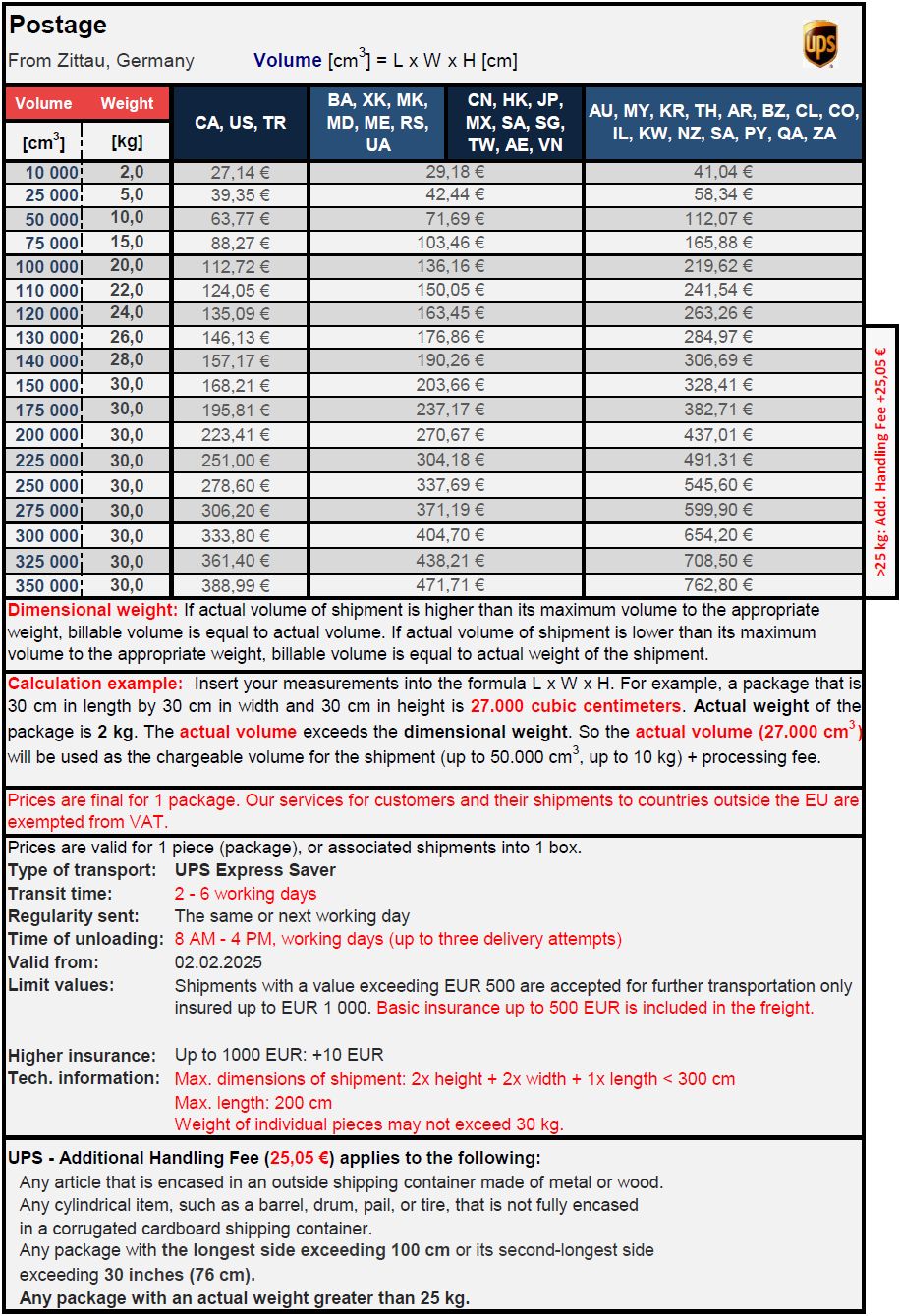
Estimated Transit Time Table
The following table provides estimated transit times for various shipping routes to Germany, comparing sea and air freight options:
| Origin | Destination | Sea Freight (Days) | Air Freight (Days) |
|---|---|---|---|
| China | Germany | 25-35 | 3-5 |
| USA | Germany | 15-25 | 5-7 |
| Brazil | Germany | 20-30 | 5-10 |
| Australia | Germany | 30-40 | 6-8 |
Context and Explanation
The estimates provided in the table above represent port-to-port transit times, meaning they reflect the duration from the departure port to the arrival port in Germany. It’s important to note that these estimates do not include the time required for customs clearance, domestic transportation, or any potential delays caused by unforeseen circumstances.
To effectively plan for shipping to Germany, businesses should account for these additional factors. For instance, while air freight offers a faster option, it may also be subject to higher costs and potential delays due to customs inspections. On the other hand, while sea freight is more economical, it requires more extended planning due to its longer transit times.
Furthermore, shippers should stay informed about potential disruptions in shipping schedules due to weather conditions, port congestion, or global events that can affect logistics. Establishing strong relationships with freight forwarders can help mitigate risks associated with delays and ensure that all necessary documentation is in order for smoother customs processing.
In conclusion, understanding the variables that influence transit times is essential for any business involved in international shipping to Germany. By considering these factors and planning accordingly, businesses can optimize their shipping strategies and ensure timely deliveries to meet their operational needs.
Navigating Customs Clearance: A Step-by-Step Guide
The Process Explained
Navigating customs clearance when shipping to Germany can be a complex but manageable process. Here’s a step-by-step workflow that you can follow to ensure a smooth experience:
-
Pre-shipment Preparation
Before you even send your package, ensure that you understand Germany’s import regulations. Research the type of goods you are shipping to confirm if any restrictions or special requirements apply. -
Gather Required Documentation
Collect all necessary documents required for customs clearance. This includes the Commercial Invoice, Packing List, and any other relevant documents. Ensure all details are accurate to avoid delays. -
Submit Customs Declaration
Complete the customs declaration forms, which detail the contents of your shipment. This is typically done online through your freight forwarder or shipping carrier’s platform. -
Pay Duties and Taxes
Once your customs declaration is submitted, you will receive information regarding any applicable duties and taxes. Be prepared to pay these fees promptly to avoid delays in clearance. -
Customs Inspection
Your shipment may be subject to a customs inspection, which can occur randomly or due to discrepancies in documentation. Be ready to provide additional information if requested.
-
Release of Shipment
Upon successful clearance, customs will release your shipment for delivery. Your carrier will then arrange for the final leg of transportation to the destination address. -
Post-delivery Compliance
After delivery, ensure compliance with any local regulations, especially if your shipment includes controlled or regulated items. Keep records of all documents for future reference.
Essential Documentation
Having the correct documentation is vital for ensuring a seamless customs clearance process. Below are the essential documents you will need:
-
Commercial Invoice: This is a critical document that provides details about the transaction, including the buyer, seller, description of goods, and their value. It acts as a bill for the goods and is necessary for calculating duties.
-
Packing List: This document details the contents of each package being shipped. It includes information such as the weight, dimensions, and quantity of items. Customs uses this to verify the shipment against the commercial invoice.
-
Bill of Lading (BOL): This is a legally binding document between the shipper and carrier. It serves as a receipt for the shipment and outlines the terms of the transportation agreement.
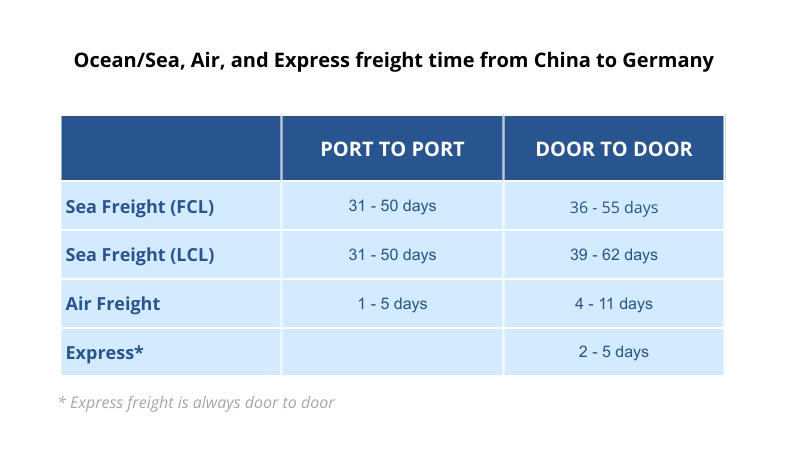
-
Customs Declaration Form: This form provides customs with essential details about the shipment, including its value, description, and origin. It is crucial for the customs assessment process.
-
Certificate of Origin (if applicable): This document certifies the country in which the goods were manufactured. It may be required for certain products to qualify for preferential tariff rates.
Duties, Taxes, and HS Codes
When shipping goods to Germany, understanding duties, taxes, and Harmonized System (HS) Codes is essential for compliance and cost management.
-
HS Codes: The Harmonized System is an internationally standardized system of names and numbers used to classify traded products. Each product is assigned a unique HS Code that helps customs authorities identify the goods and apply the appropriate tariffs.
-
Duties and Taxes: Import duties are calculated based on the value of the goods, which includes the cost of the items, shipping fees, and insurance. In Germany, the Value Added Tax (VAT) is also applicable and is typically charged at 19%. The specific rate may vary depending on the type of goods being imported. Ensure that you have calculated these costs in advance to avoid surprises.
Common Problems & Solutions
Even with careful planning, issues can arise during customs clearance. Here are some common problems and solutions to help you navigate potential pitfalls:
-
Incorrect Documentation
Problem: Missing or incorrect documents can lead to delays or fines.
Solution: Double-check all documentation before shipment. Use a checklist to ensure you have everything required, and consider consulting with a customs broker if you’re unsure.
-
Inaccurate Valuation
Problem: Misstating the value of goods can result in penalties.
Solution: Ensure that the value declared matches the market value and is supported by the commercial invoice. Be transparent in your declarations. -
Customs Delays
Problem: Shipments can be delayed due to customs inspections or backlog.
Solution: Plan for potential delays by allowing extra time in your shipping schedule. Use expedited shipping options if necessary and keep communication open with your freight forwarder. -
Restricted Items
Problem: Shipping prohibited or restricted items can lead to confiscation.
Solution: Research Germany’s import restrictions thoroughly. If in doubt, consult with customs authorities or a freight forwarder. -
Failure to Pay Duties Promptly
Problem: Delayed payment of duties and taxes can hold up your shipment.
Solution: Stay organized and be prepared to make payments as soon as you receive duty notifications. Setting up an account with your shipping provider can streamline this process.
By following these guidelines, you can navigate the customs clearance process more effectively when shipping to Germany, ensuring a smoother experience and minimizing the risk of delays or fines.
A Practical Guide to Choosing Your Freight Forwarder
Understanding the Importance of Choosing the Right Freight Forwarder
Selecting the right freight forwarder is crucial for businesses looking to ship goods internationally, particularly to Germany. A reliable freight forwarder not only helps streamline the shipping process but also ensures compliance with regulations, manages logistics effectively, and can ultimately save you money. Here’s a practical guide to assist you in making an informed decision.
Key Qualities to Look for in a Freight Forwarder
When evaluating potential freight forwarders for shipping to Germany, focus on the following essential attributes:
-
Experience and Expertise
A forwarder with a solid track record in international shipping and specific experience with the German market will be more adept at handling your logistics needs. Look for forwarders that have dealt with similar products or industries. -
Global Network
A well-established network of agents, carriers, and partners is vital. This network will enable the forwarder to offer competitive rates, efficient shipping routes, and timely deliveries, while also providing access to local expertise in customs and regulations. -
Licensing and Compliance
Ensure that your freight forwarder is fully licensed and compliant with international shipping regulations. In the U.S., for example, they should be a licensed Customs Broker, while in Europe, they must adhere to the European Union customs regulations. This compliance is crucial for smooth customs clearance. -
Effective Communication
Choose a freight forwarder that prioritizes clear and timely communication. This will facilitate updates on shipment status, potential delays, and other critical information. A forwarder that offers online tracking tools can enhance transparency and reduce anxiety. -
Value-Added Services
Look for additional services such as customs brokerage, insurance options, warehousing, and packaging. These services can simplify the shipping process and provide added security for your goods.
Sourcing Checklist for Choosing Your Freight Forwarder
To streamline your selection process, follow this actionable checklist:
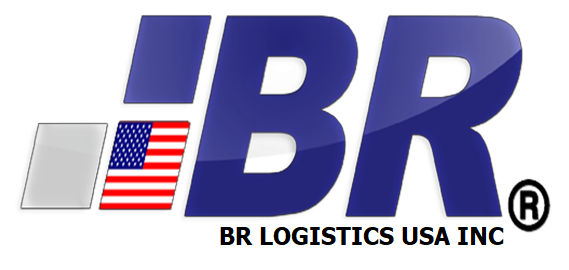
-
Define Your Shipping Needs
Clearly outline your shipping requirements, including the type of goods, volume, frequency of shipments, and specific routes to Germany. -
Research Potential Forwarders
Conduct thorough research to identify freight forwarders that specialize in shipping to Germany. Utilize online platforms, industry directories, and recommendations from peers. -
Request Quotes
Contact shortlisted forwarders to request detailed quotes. Make sure to ask for a breakdown of costs, including freight charges, insurance, customs duties, and any additional fees. -
Ask Questions
Engage with potential forwarders and ask pertinent questions. Inquire about their experience with shipping to Germany, their handling of customs documentation, and how they manage delays or issues. -
Check References
Request references from past clients to gauge the forwarder’s reliability and service quality. Speaking to other businesses that have used their services can provide invaluable insights.
Red Flags to Watch Out For
When choosing a freight forwarder, be vigilant for the following warning signs that may indicate potential issues:
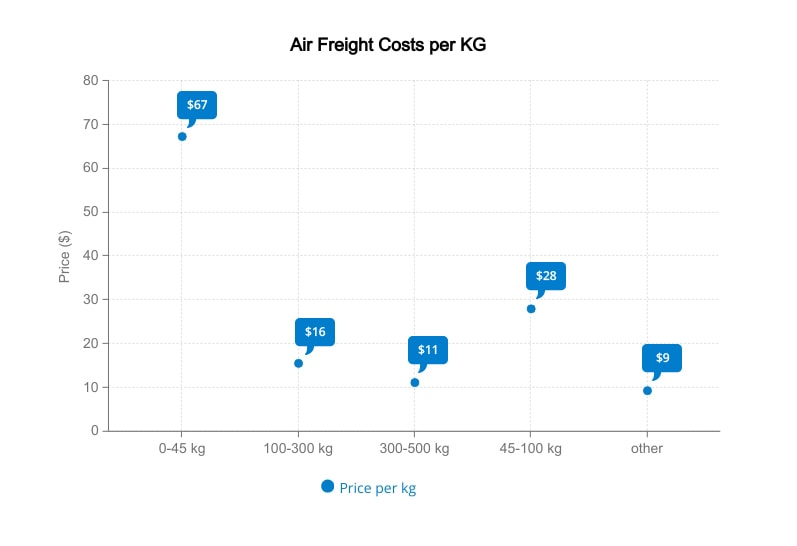
-
Lack of Transparency
If a forwarder is unwilling to provide clear information regarding costs, services, or processes, consider it a red flag. Transparency is essential for establishing trust. -
Poor Communication
Difficulty in reaching a representative or receiving timely responses can indicate poor customer service. A reliable forwarder should prioritize communication. -
Negative Reviews or Feedback
Conduct an online search for reviews and testimonials. Consistently negative feedback or unresolved complaints should raise concerns about the forwarder’s reliability. -
Inadequate Licensing
Ensure that the forwarder has the necessary licenses and certifications. If they cannot provide proof of compliance, it may lead to significant legal and financial issues down the line. -
High Pressure Sales Tactics
Be wary of forwarders that pressure you to make quick decisions or sign contracts without allowing you to thoroughly review the terms. A reputable freight forwarder will understand the importance of informed decision-making.
Conclusion
Choosing the right freight forwarder for shipping to Germany can significantly impact your business’s efficiency and bottom line. By focusing on key qualities, following a structured sourcing checklist, and being aware of potential red flags, you can find a partner that aligns with your shipping needs and helps facilitate a smooth logistics process. Remember, the right forwarder not only navigates the complexities of international shipping but also becomes a valuable ally in your business growth.
Incoterms 2020 Explained for Shippers
Understanding Incoterms
Incoterms, or International Commercial Terms, are a set of predefined rules published by the International Chamber of Commerce (ICC) that define the responsibilities of buyers and sellers in international trade. They clarify who is responsible for transportation costs, insurance, and the risk of loss or damage to goods while they are in transit. Understanding Incoterms is crucial for shippers, especially when calculating the total cost to ship to Germany, as they directly impact shipping expenses and liability.
Key Incoterms Table
| Incoterm | Who Pays for Transport? | Where Risk Transfers? | Best for |
|---|---|---|---|
| EXW | Buyer | At the seller’s premises | Buyers wanting maximum control |
| FOB | Seller | At the ship’s rail or port | Sellers managing ocean freight |
| CIF | Seller | At the destination port | Buyers wanting a hassle-free experience |
| DDP | Seller | At the buyer’s premises | Buyers wanting maximum convenience |
Detailed Explanation of Common Incoterms
EXW (Ex Works)
Under the EXW Incoterm, the seller makes the goods available at their premises or another named place (factory, warehouse, etc.). The buyer is responsible for all costs and risks associated with transporting the goods to their final destination. This term is ideal for buyers who want maximum control over their logistics and shipping process. For example, a Brazilian exporter shipping machinery to Germany would choose EXW if they want to manage all transport arrangements, including customs clearance and freight forwarding.
FOB (Free on Board)
FOB indicates that the seller is responsible for all costs and risks up until the goods are loaded onto the ship at the port of origin. After this point, the buyer assumes responsibility. This Incoterm is commonly used in maritime shipping. For instance, if an Australian supplier ships goods to Germany under FOB terms, they would cover the transportation to the port and loading onto the vessel, while the buyer would handle ocean freight and insurance from that point onward.
CIF (Cost, Insurance, and Freight)
CIF is a more comprehensive term where the seller pays for the cost, insurance, and freight necessary to bring the goods to the port of destination. The risk transfers to the buyer once the goods are loaded on the ship, but the seller is responsible for the insurance until the goods reach the destination port. This term is beneficial for buyers who prefer a simpler process, as it reduces their responsibilities regarding shipping logistics. For example, a German importer purchasing electronics from Brazil might opt for CIF to ensure that their goods are insured and shipped without additional hassle.
DDP (Delivered Duty Paid)
DDP places the maximum obligation on the seller, who is responsible for all costs and risks associated with transporting the goods to the buyer’s location, including duties and taxes. This term is especially advantageous for buyers who want a straightforward shipping process without worrying about customs or additional fees. For example, if a business in Germany orders products from an exporter in Australia under DDP terms, the seller will manage all logistics and cover all costs, delivering the goods directly to the German company’s doorstep.
Conclusion
Selecting the right Incoterm is vital for shippers looking to optimize their shipping costs and manage risks effectively when sending goods to Germany. By understanding the implications of each term, businesses can tailor their shipping strategies to better fit their operational needs and ensure smooth transactions across borders. Whether a shipper prefers to maintain control over logistics or seeks a hassle-free experience, the right Incoterm can significantly impact the overall cost and efficiency of international shipping.
Risk Management: Identifying and Mitigating Common Shipping Problems
Introduction
In the realm of international shipping, particularly when navigating the complexities of sending goods to Germany, proactive risk management is essential. Effective risk management not only safeguards your shipment but also enhances customer satisfaction and protects your bottom line. By identifying potential risks early and implementing strategies to mitigate them, businesses can minimize disruptions and ensure a smoother shipping experience. This guide will delve into common shipping problems encountered when sending goods to Germany, offering practical solutions to help shippers navigate these challenges successfully.
Risk Analysis Table
| Potential Risk | Impact | Mitigation Strategy |
|---|---|---|
| Cargo Damage | Financial losses, delays in delivery, customer dissatisfaction | Invest in high-quality packaging materials, conduct thorough inspections before shipping, and use reliable carriers with good reputations for handling cargo. |
| Delays | Increased shipping costs, potential loss of customers | Choose expedited shipping options when necessary, maintain open communication with carriers, and monitor shipment status regularly to anticipate delays. |
| Customs Holds | Extended delivery times, potential fines, or loss of goods | Ensure all documentation is accurate and complete, engage customs brokers for assistance, and familiarize yourself with Germany’s customs regulations and requirements. |
| Regulatory Compliance | Legal ramifications, fines, and shipment rejections | Stay updated on shipping regulations, particularly those related to product safety, labeling, and import restrictions. Regular training for staff on compliance can help. |
| Theft and Loss | Financial losses, disruption in supply chain | Utilize tracking services, ensure proper insurance coverage, and choose secure shipping methods. Implement security measures at warehouses and during transit. |
| Currency Fluctuations | Increased costs or reduced profit margins | Use hedging strategies or forward contracts to lock in exchange rates, and consider pricing strategies that accommodate potential fluctuations. |
Cargo Insurance Explained
Cargo insurance is a crucial aspect of international shipping, providing financial protection against potential losses or damages to goods while in transit. Understanding the types of cargo insurance available and their coverage can help businesses mitigate risks effectively.
Types of Cargo Insurance
-
All-Risk Insurance: This comprehensive option covers all types of loss or damage, except for specific exclusions outlined in the policy (e.g., inherent vice, wear and tear).
-
Named Perils Insurance: This policy covers only specific risks that are explicitly listed, such as theft, fire, or collision. It is generally more affordable but offers less comprehensive protection.
-
General Average Insurance: This type protects the shipper against losses incurred when cargo is sacrificed to save the ship (e.g., jettisoning cargo during a storm). It can be critical for high-value shipments.
-
Inland Transit Insurance: Often overlooked, this insurance covers goods while they are transported overland to the port of shipment or from the port of discharge to the final destination.
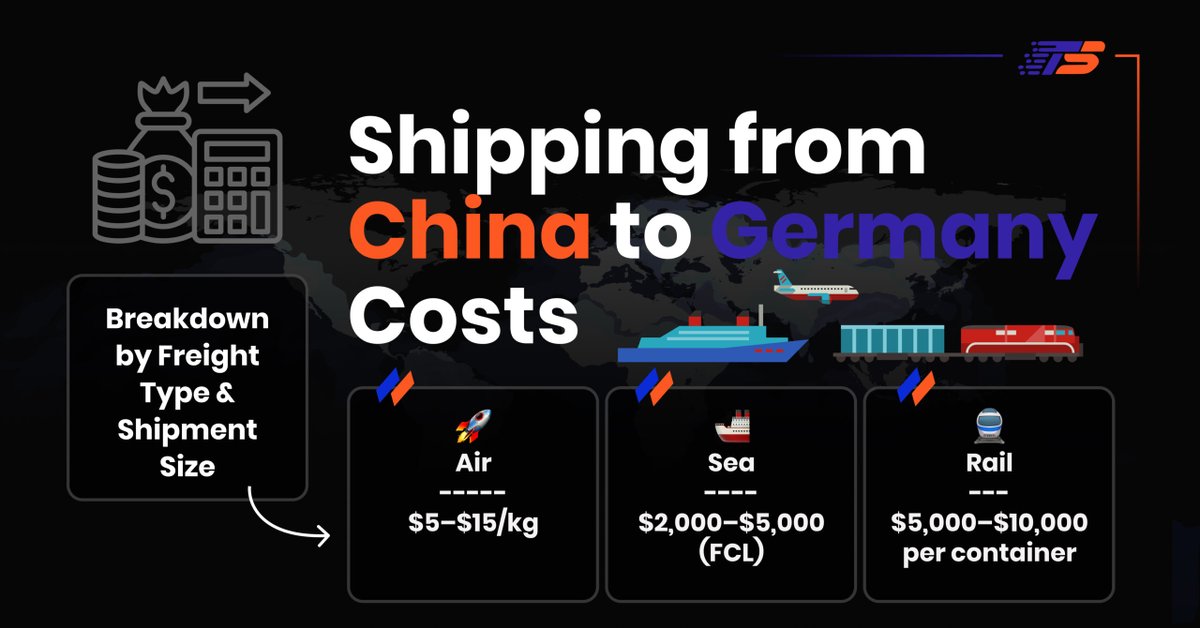
Importance of Cargo Insurance
Cargo insurance is essential for several reasons:
-
Financial Protection: It safeguards your investment in goods, ensuring that losses due to theft, damage, or other unforeseen incidents do not significantly impact your finances.
-
Peace of Mind: Knowing that your shipment is insured allows you to focus on other aspects of your business without the constant worry of potential losses.
-
Enhanced Credibility: Having cargo insurance demonstrates to your customers that you take shipping seriously and are committed to protecting their interests.
-
Compliance with Requirements: Some countries or carriers may require proof of insurance for specific shipments, making it essential for smooth customs clearance.
Conclusion
Navigating the complexities of shipping to Germany involves understanding and managing various risks that can arise throughout the process. By proactively addressing these potential challenges through effective risk management strategies, including the use of cargo insurance, businesses can minimize disruptions, protect their investments, and enhance overall operational efficiency. As international shippers, it is critical to remain informed and prepared, ensuring that your shipments arrive safely and on time, ultimately leading to greater customer satisfaction and business success.

Frequently Asked Questions (FAQs) for cost to ship to Germany
1. What factors influence the cost to ship to Germany?
Shipping costs to Germany are influenced by several factors including the weight and dimensions of the package, the shipping method selected (e.g., express vs. standard), the origin of shipment, and any additional services required such as tracking or insurance. Customs duties and taxes may also apply, depending on the value and nature of the goods.
2. How can I calculate shipping costs to Germany?
To calculate shipping costs, you can use online shipping calculators provided by carriers like UPS, FedEx, or USPS. By entering details such as package dimensions, weight, and destination, you can obtain a quote. Additionally, consider contacting freight forwarders for comprehensive quotes that include customs duties and other fees.
3. What is the average shipping time to Germany?
Average shipping times to Germany vary by service. For example, express services may take 1-3 business days, while standard shipping can take anywhere from 6-10 business days. Factors such as customs clearance and local delivery conditions can affect these timelines.
4. What is chargeable weight, and how does it affect shipping costs?
Chargeable weight is the greater of the actual weight or the volumetric weight of a package. Carriers calculate volumetric weight by multiplying the dimensions of the package and dividing by a dimensional factor (often 5000 cm³/kg). Understanding chargeable weight is crucial, as it may increase shipping costs significantly for lightweight but bulky items.
5. Are there customs duties and taxes when shipping to Germany?
Yes, shipments to Germany may incur customs duties and VAT (Value Added Tax) based on the value of the goods. The duty rates vary depending on the type of goods being shipped. It’s advisable to research the specific regulations for your goods and potentially consult with a customs broker to ensure compliance.
6. What is the difference between a Bill of Lading (BOL) and an Air Waybill (AWB)?
A Bill of Lading (BOL) is a legal document between a shipper and a carrier that details the type, quantity, and destination of the goods being shipped. It is often used for ocean freight. An Air Waybill (AWB), on the other hand, is used for air freight and serves as a receipt for goods and a contract of carriage, but it is not a document of title. Understanding these differences is important for proper documentation during shipping.

7. How can I ensure my package clears customs smoothly?
To ensure smooth customs clearance, provide accurate and detailed descriptions of the goods being shipped, including their value and purpose. Ensure all necessary customs forms are completed correctly. It may also be beneficial to engage a customs broker who can navigate the complexities of international shipping regulations.
8. What shipping services offer tracking to Germany?
Most major carriers, including USPS, UPS, FedEx, and DHL, offer tracking services for shipments to Germany. Depending on the service level chosen, tracking may be included at no extra charge or available as an add-on service. Tracking allows you to monitor the shipment’s progress and receive updates on its status.
9. Can I consolidate multiple packages to save on shipping costs?
Yes, package consolidation is a service offered by many freight forwarders and shipping services. By combining multiple packages into one shipment, you can often reduce shipping costs significantly. This is especially beneficial for businesses that regularly send multiple items to the same destination.
10. What are the best practices for packaging items for shipping to Germany?
To ensure safe and cost-effective shipping to Germany, use sturdy packaging materials that can withstand handling and transit. Include sufficient cushioning for fragile items and ensure that the dimensions and weight of the package are accurately measured to avoid unexpected charges. Clearly label the package and include all necessary customs documentation to facilitate smooth processing.
Conclusion: Key Takeaways for Successful Shipping
Planning for Successful Shipping
Effective shipping to Germany requires thorough planning and a strategic approach. Understanding the logistics landscape is crucial; familiarize yourself with customs regulations, shipping options, and delivery timelines. Utilizing shipping calculators provided by carriers like USPS and UPS can help you estimate costs accurately and choose the most economical solutions for your needs.
Choosing the Right Partners
Selecting reliable shipping partners is a critical factor in ensuring smooth international shipments. Collaborate with well-established freight forwarders and carriers that offer comprehensive services, including tracking and insurance. Companies like MyUS provide package consolidation and exclusive rates that can significantly reduce shipping costs. Building strong relationships with these partners can lead to better pricing and improved service levels over time.
Understanding Costs
Shipping costs can vary widely based on weight, dimensions, shipping speed, and the carrier selected. For instance, USPS offers a range of services from affordable options like First-Class Package International Service to expedited choices like Priority Mail Express International. Additionally, consider all potential fees, including customs duties and taxes, to avoid unexpected expenses. Regularly review and compare shipping rates to ensure you are getting the best deal available.
Call to Action
In the dynamic world of international shipping, staying informed and adaptable is key. By planning effectively, selecting the right partners, and understanding the intricacies of shipping costs, you can streamline your shipping process to Germany. Don’t hesitate to reach out to logistics experts or utilize online resources to enhance your shipping strategy. Start optimizing your shipping today—your business and your bottom line will thank you!
Important Disclaimer
⚠️ Important Disclaimer
The information in this guide is for educational purposes only and does not constitute professional logistics advice. Rates, times, and regulations change frequently. Always consult with a qualified freight forwarder for your specific needs.



